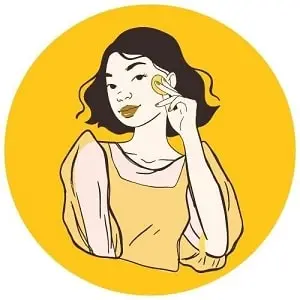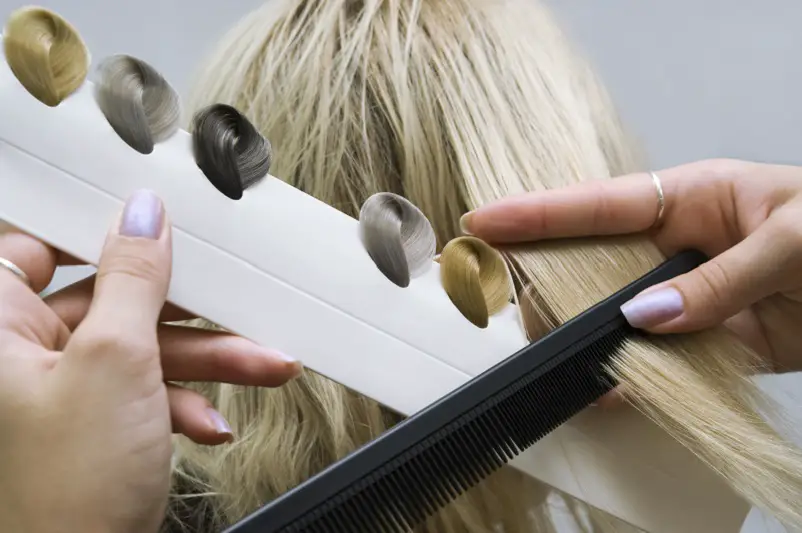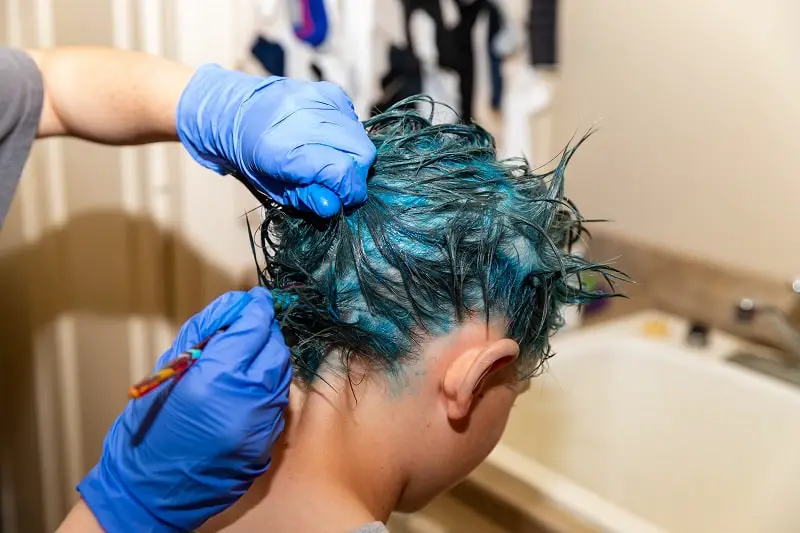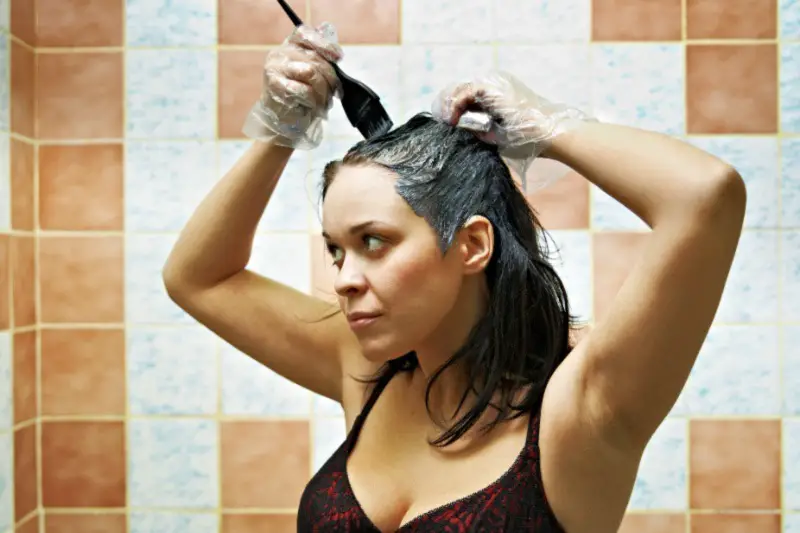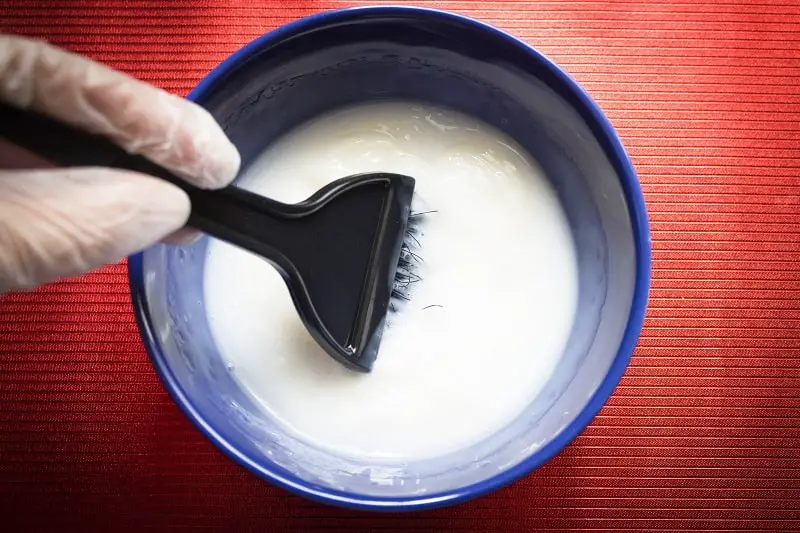Can I tone my hair twice? While you can absolutely tone your hair twice, you shouldn’t tone it twice in the same day. For some background, hair toner is most often used to correct the yellowness or brassiness that follows the use of hair bleach.
This article will review toners in their totality, so feel free to sit back, relax, and refresh your knowledge about hair toners with the information below. Who knows, maybe we will be able to answer some of your most burning questions about toning!
Can You Tone Your Hair Twice In One Day?
It is not recommended to tone your hair twice in one day. Even though most toners are ammonia-free and do not require the use of a developer, they still rely on base ingredients that could be damaging to the hair if repeatedly exposed.
Most of the time, potential damage is primarily a concern for toners that have a higher pH, since they are more alkaline (and therefore more aggressive) in their toning process.
Alkaline leaning hair toners also have the ability to somewhat lift natural hair colors and should be avoided for only partial lightening processes like highlights and balayage.
On another hand, acidic toners are significantly less aggressive. Their pH is lower, and will gently guide the hair back to a natural, slightly acidic state.
Fun fact: hair is a bit acidic, with a pH level between 4.5 – 5.5. If you are faced with balancing richly pigmented or unevenly colored hair, acidic toner likely won’t do much for you—opt for alkaline toners instead.
Generally, you would want to choose a hair toner with the right pH to fit your desired results. Unfortunately, there is no such thing as a toner that can do it all (though that would be nice, huh).
Can I Tone My Hair Twice In A Week?
No, you should not tone your hair twice a week. As a rule of thumb, avoid toning your hair prior to 4-8 weeks after the first toning. Above all else, your hair needs time to adjust and recover from being bleached.
As you can probably imagine, bleaching leaves the hair shaft in a vulnerable place; so, repeated toning in a close time frame can cause some serious damage to your lovely locks.
Usually, you don’t want to re-tone your hair unless you absolutely need to. This means you should probably hold off on breaking out the toner until your newly light blonde hair begins to turn brassy, instead of doing so beforehand.
Now you may be wondering: what about toning shampoos? Well, they’re great for a quick color refresh. In the case of using a violet or blue toner shampoo, the use should be limited to once or twice a week and it definitely should not replace your go-to shampoo and conditioner combo.
Likewise, color-depositing conditioners can neutralize warm undertones and brassiness in a similar fashion. Neither are necessarily as damaging as an entire stand-alone toner, but they should be used only as directed as excessive use can cause build-up that leads to brittle strands and a dull appearance.
How Long Should I Wait To Tone My Hair Again?
It is preferable to wait 4-8 weeks between toning sessions. This time frame is ideal for using permanent and demi-permanent toner types, while semi-permanent toners can be used once or twice a week for a quick touch-up.
Otherwise, you want to use toners with some degree of caution. Frankly, nothing is worse than unnecessary damage to your hair. It is best to avoid it if you can.
That being said, toners can be more harmful than good in some cases and can actually worsen any present damage your hair is experiencing if used in excess.
Never use toner twice in a day, or more than once a week, and keep your applications a month apart at minimum for the sake of the health of your hair. Also, if your hair has had a real go of it and is particularly damaged, wait two months until you tone it again.
Will Wella T18 Tone Orange Hair?
Yes, Wella T18 will tone orange hair! That is its job, after all. Since this specific toner will create a beautiful ash undertone, Wella T18 works wonders on hair that is particularly discolored towards an orangey color. As a toner, Wella T18 will deposit cool undertones of violet, blue, and gray.
If you are planning on using Wella T18, your desired results likely lay along the lines of a cool ash blonde or an eye-catching platinum. On the other side of the spectrum, Wella does offer toners that will grant warm undertones if that is what you are looking for instead.
To check out more Wella products, you can find the brand carried at most Sally stores, or on various e-commerce beauty stores. Here you can find select Wella toners on Amazon. They even have their very own Wella Professionals website.
Why Is My Hair Still Orange After Toning?
If your hair is still orange after toning, make sure you use a blue toner next time around. Unfortunately, there is no one-size-fits-all umbrella hair toner. You will have to diagnose the exact color issue you’re having before using a corrective product.
In order to figure out what exact toner color is best for you look no further than a standard color wheel. After identifying what color you want to eliminate, go to the exact opposite of the wheel to find the toner you need.
For example, if your hair is showing up green, opt for a toner with red pigments. If yellows are ruining your look, try out a purple toner. But, if your issue is orange, use blue.
How Do I Prepare My Hair To Tone It For A Second Time?
There are a few ways you can prepare your hair for a second round of toning, but above all else you want to make sure your hair is moisturized. That’s right: it is time for a deep conditioning hair mask.
While any conditioning treatment can feasibly work, tons of folk out there are swearing by coconut oil hair masks. They’re easy to do, inexpensive, and get the job done. Even better? This handy-dandy mask can be prepared and done from the comfort of your home.
To prepare a coconut oil hair mask simply follow the steps below:
- Carefully measure out 2 tablespoons of coconut oil into a sauce pan. Bear in mind that the amount may vary depending on your hair’s thickness—if your hair is thinner or more fine, then a single tablespoon may work better.
- Turn the burner on low and slowly heat the coconut oil.
- Once the coconut oil has liquified, remove from heat.
- While the oil is still warm, carefully massage the oil from the roots of your hair to the tips. You should avoid handling hot oil at the risk of burns, so make sure you give the coconut oil ample time to reach ~65 degrees.
Ideally, don’t use a conditioning hair mask the day-of, instead applying it throughout the weeks leading up to the big day. And before we forget, there are no rules that say you can’t apply cool oil to your hair—room temperature coconut oil can work just as well.
How Do I Apply Hair Toner A Second Time After 6 Weeks?
After a 6 week grace period, apply your hair toner just as you would normally. There’s really no special steps to take for applying toner a second time around.
As usual, follow the directions on your select toner of choice. In the case of toners with ammonia, you will need to mix the product with appropriate amounts of developer.
Otherwise, simply apply the toner to damp hair and monitor your time carefully. Most toners need to only sit between 20 and 45 minutes, though the exact time does depend on the brand used.
Remember that mistakes can happen, especially in beauty regimes. Look out for going over the amount of time required for your hair toner, as you could end up with some messy consequences akin to extensive hair damage and flat, undesirable undertones.
On the flip side, leaving the toner on for too short of a time isn’t as dire of a situation. Of course, you won’t achieve that look, but you won’t risk any crazy damage to your hair either.
Is Toning Your Hair Damaging?
To some degree, yes: toning your hair can be potentially damaging. Speaking on that, correctly using hair toners should have minimal negative effects on your hair, if any.
The potential damage caused by toners is the leading reason why toning twice in a row is a huge no-no. Similarly, it is the reason to space out your toning sessions.
Since toners are usually applied as a corrective following hair bleaching, you are technically adding chemicals to hair that is in a fragile state. Naturally, too much of these chemicals can overburden the hair.
Look out for hair that is crunchy, dry, brittle, or dull. In addition to this, keep an eye out for notable hair loss from damages. A solution to this could be using a porosity equalizer prior to toning.
Porosity equalizers act as protective barriers to shield your hair from further damage. They are chalked-full of minerals and proteins that help balance hair porosity to ensure even color absorption.
But, what is porosity? And why is it so important? Hair porosity is your hair’s ability to absorb and retain moisture. People tend to fall into three categories with porosity, which include low, medium, and high porosity levels.
Low porosity means your hair has some trouble with retaining moisture. Although naturally occurring, low porosity can be caused by damaging hair treatments like bleaching, and the use of hot tools (blow dryers, straighteners, curlers, etc).
Ultraviolet exposure can also trigger low porosity. Medium porosity is the happy middle ground for hair. Your hair retains moisture well, which makes coloring and styling a breeze. Hair that is of medium porosity is known to be shiny, bouncy, and overall healthy.
High porosity hair is the other end of the spectrum. Where there will be no issue absorbing moisture, the hair won’t hold onto it for long. Limp hair that is easy to break are some tell-tale signs of high porosity hair. Additionally, you may notice that your hair is dry or frizzy.
The biggest fear after bleaching is the development of low-porosity hair, which makes even coloring difficult to achieve. Using a porosity equalizer can help address the hair’s inability to retain moisture enough to achieve a unified color after toning.
If you are DIYing your new do, check out brands like Kenra, Ion, and Schwarzkopf for their lines of porosity equalizers—they are available at most in-person beauty stores.
Final Thoughts: Can I Tone My Hair Twice?
To concisely summarize all of this information: hair toners are as varied as hair itself. While you won’t exactly find a single toner for all of your toner needs, you will be able to find the perfect toner for you with a little bit of analysis on your part.
Take a look at a color wheel to help you figure out what exact color of toner you require; to do this, figure out what color you are trying to cancel out. The color immediately opposite of your “problem” color will be the color of toner you should use.
Keep in mind that most toners are ammonia-free, with the lone exception being permanent toners that are used in cases where an intense blonde is the desired outcome. Demi and semi-permanent toners are more flexible and a majority of the selection is ammonia-free.
What this means is that permanent toners can pose more damage on your hair when compared to other toner options. Continuing on, hair toners are generally damaging, but the extent of which is minimal when safely and appropriately used.
If your hair is showing signs of bleach damage (brittleness, dryness, split ends, hair loss, knots) then we recommend using a porosity equalizer prior to applying any toner. The equalizer is a mineral-rich protectant that will help evenly distribute color while offering your hair a reprieve.
In all, hair toners are a great way to add depth to your hairstyle—they add undertones of your choice while simultaneously enhancing and neutralizing other pigments. Next time you find yourself bleaching your hair, make sure you reach for a reliable toner to give your new look that wow factor!
If you enjoyed reading this article, check out some of our other amazing blog posts:
